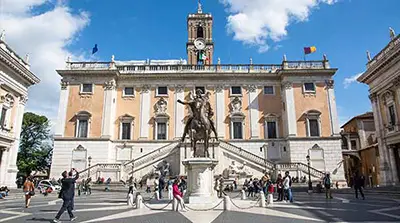The Palazzo Senatorio adorns the top of the building known as the Tabularium which is the building that housed all of the city records. The The Palazzo Senatorio is now owned by the Roma Capitale.
It became the City Hall back in 1870. Today the Palace is used as the central office for the municipality of Rome. The Palazzo Senatorio was originally constructed in its present location to offer solitude and contemplation because of its remote and elevated placement within the city of Rome. Today the Palazzo Senatorio offers stunning views of the Saint Maria in Aracoeli.
The Palazzo Senatorio was radically redesigned in the fourteenth century with Michelangelo made responsible for the design of the monumental steps. Michelangelo was also responsible for designing the Cordonata or staircase, of the Piazza del Campidoglio.
The Palazzo Senatorio is located within the Piazza del Campidoglio and the entire square is built upon Capitoline Hill, which looks down upon the imposing Vittorio Emanuele monument. The Palazzo Senatorio is a dominating structure that is comprised of heavy stone.
When Michelangelo redesigned the structure in the 1500s he very much based his design upon the Rennausance theme and style of building. This was one of the reasons that he decided to keep the majestic, but single, staircase, choosing instead to work with, and to embellish it, making it the iconic staircase it is today. The staircase is located in the central plaza and visitors from all over the world flock to savour its splendour.
The staircase when reassigned by Michelangelo took on a completely new look and dynamic. The staircase was most unusual as he chose to construct a double staircase making them appear mighty and majestical. This was on the request made by Pope Paul III who wanted to impress Charles V, the leader of the Roman Empire.
Michelangelo chose to replace the single staircase with a double staircase, making the steps wider and more accessible. The steps are integral to the look and feel of the entire Palace as they dominate the building.
The staircase begins at the bottom of each wing, and slopes gently upwards, until it reaches the top corner, where they then blend into the building's facade. The two staircases then meet together, centrally, at the second story in front of the grand doorway.
Michelangelo worked with the structure of the building and created this beautiful staircase that works with the building, to further enhance its beauty, as well as creating the staircase in its own right, as a part of the building that can be contemplated and observed on its own. There is also a beautiful and decorative fountain that is located in front of the lavish staircase that depicts the gods of the Rivet Nile and Tiber. Part of this fountain was also designed by Michelangelo.
The Palazzo Senatorio has a wide, varied and interesting history. Originally it was built as a means of defending the city during the troubled Middle Ages, due to the fact hat it was located high above the city, as well as being solid and impenetrable. During the twelfth century, the Palace was the central seat of the city, and was used for administrative purposes. Once again, this was probably due to its imposing nature and placement that offered solitude.


